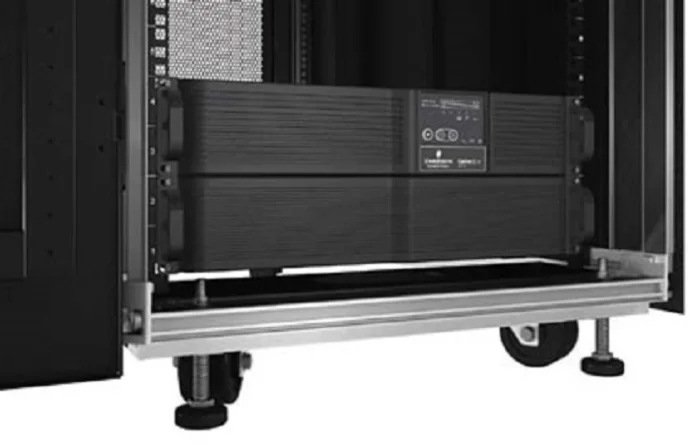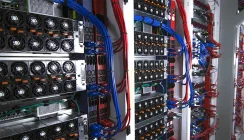Uninterruptible Power Systems for Server Rack Power Protection
There are several key choices to make when it comes to selecting the right uninterruptible power supply to install with a server rack. These include not only the topology but the load size, form factor, runtime, access for maintenance and connectivity.
UPS System Topology
Most organisations choose to house their servers and IT network devices in a server rack, and it is not surprising to find uninterruptible power supplies installed within the same cabinet. One of the key questions when selecting a UPS for a server rack is the actual design topology. The primary choice is one between an on-line uninterruptible power supply and a line interactive one.
On-line UPS provide the most comprehensive power protection. The load is connected to the UPS inverter which provides a digitally generated sinewave output. Often the waveform is superior to that of the mains power supply. This ensures that the switch mode power supply at the heart of the server and other IT devices are provided a source of regulated and conditioned power that is within the mid-point of their input voltage and frequency windows. Electronic components within the power supply are rarely stretched ensuring overall reliability and a long working life.
At the input to an online UPS system is a rectifier/charger assembly. The converters the incoming AC (alternating current) waveform into two levels of DC (direct current). One charges the battery set and internal capacitance and the other powers the inverter. When the mains power supply fails or fluctuates wildly, the inverter draws power instantaneously from the battery set. The supply to the load is ‘uninterruptible’ and without a break.
Aside from the ability to provide a break-free electrical supply, an on-line uninterruptible power supply also has a built-in automatic transfer switch. This provides safe ‘failure-to-mains’ if the UPS inverter is overloaded or develops a fault condition. A circuit monitors the output of the inverter and when the output waveform starts to collapse (due to a short-circuit or fault) the bypass automatically activates.
Additional resilience can be built-into an on-line power protection plan using on-line UPS with the ability to operate in an N+1 configuration. Some single-phase UPS systems now offer this as an additional feature when the uninterruptible power systems are installed with parallel cards.
The alternative to an on-line device is to install a line interactive UPS. This type of UPS offers less comprehensive power protection but is cheaper in cost. The line interactive UPS typically has a built-in automatic voltage stabiliser to regulate and stabilise the mains power supply. The inverter will usually be inactive but powered and will provide the load with power from the battery set when the mains power supply fails. The inverter activation will incur a short break in the supply which is covered by capacitance within the switch mode power supplies of the connected loads. The output waveform may be a sinewave, step-wave or square-wave.
For more information on UPS topologies see: https://ieeexplore.ieee.org/document/989305
Load kVA Size
Of course the UPS must be sized for the loads to be powered within the rack but how far ahead can this be forecast? Whilst virtualisation has shrunk the amount of IT hardware in a typical computer room or datacentre, power demands have increased. Edge computing and the Internet of Things (IoT) continues to IT network growth. The general rule of thumb in the industry is to allow 25% extra capacity for expansion whether sizing in kVA or kW. If in the future a UPS is found to be under-sized, a new UPS system may have to be purchased either for the total load or to support the additional demands. This potential growth problem can be overcome by selecting a modular UPS but with a price penalty of a traditional monoblock type system. There are also few modular systems available for single phase installations.
UPS Form Factor and Placement
The most common form factors for a UPS system include desktop, tower and rack mount. Dual format units are also available that can be installed as either tower or 19inch rack mount systems. These types of UPS typically have a front panel display that can be turned 90˚ for the installation format.
When installing a UPS in a server rack, the most commonly accepted practice is to install a rack mount system and use rail slides. These attach to the rack frame and the UPS case and allow the UPS to be slide in or out of position in the rack. The slide rails must be rated for the weight of the UPS and any extra battery trays. A rack mount UPS can also be installed onto a suitable shelf as can a tower or desktop UPS if there is enough headroom (height).
Heat rise and within a server rack it is not uncommon to find hotspots. The batteries within the UPS power system will generally be sealed lead acid (SLA) maintenance free. Lithium-ion battery options are slowly becoming available but with a high cost factor compared to lead acid. The issue for lead acid batteries is that they are more temperature sensitive and require an ambient of 20-25˚C in order to meet their working life expectations. For 5-year design life valve regulated lead acid (VRLA) batteries this is generally 3-4 years and 7-8 years for 10-year design life batteries. For every 1˚C rise about 30˚C the design life halves. For this reason it is important to place the UPS in the lower half of the server rack and to ensure good ventilation air flow and air conditioning.
For additional peace of mind temperature monitoring should also be placed within the server rack. This can be achieved using a separate environment monitoring device or adding temperature probes to a smart or intelligent PDUs.
UPS Battery Runtime
It is important to estimate the amount of battery runtime required from the UPS. This may be 10-30minutes to provide enough time for a local standby power generator to start-up or to complete a controlled shutdown of the IT server(s). Using battery extension packs it is possible to extend the runtime for up to several hours.
In relation to UPS topologies this can be easier to achieve with an on-line UPS than a line interactive one. Line interactive UPS inverters are not rated for long continuous operating periods and must be oversized.
Access for Maintenance
UPS systems have consumable parts in addition to life-limited battery sets. Fans and capacitors will require replacement at some stage of the system working life. Regular inspections and preventative maintenance visits are important in order to ensure the continuous availability of the UPS system. An annual maintenance visit or health check is typically included within a UPS maintenance contract along with 24/7 support and emergency call out. Options for such a contract may also include additional battery testing using a handheld testing device which can be more accurate than the battery string testing offered as a feature of the UPS system.
For critical UPS installations, it may also be necessary to install some form of external maintenance bypass switch. This may be rack mounted or wall mounted and allows the UPS to be maintained or swapped out without risk to the connected IT loads.
Connectivity and Remote Monitoring
Most uninterruptible power systems can be installed with slot-in SNMP cards. This provides the UPS with a local IP connection from which it can be monitored over the network using manufacturer specific UPS monitoring software or some form of DCIM other middleware platform. Remote monitoring is important not just from a check-up point of view but also to receive alert messages if/when the UPS alarms and allows alarm scripts to be activated including email, SMS and phone alerts.
Summary
There are several choices to make when selecting a UPS system to provide power protection not a server rack. Most UPS installed in this type of application are single phase but there are larger three phase models available including three-phase in and out 3/3 three phase in and single phase out (3/1) configured systems. If you need assistance selecting the right uninterruptible power supply for your application, please contact our projects team.


























